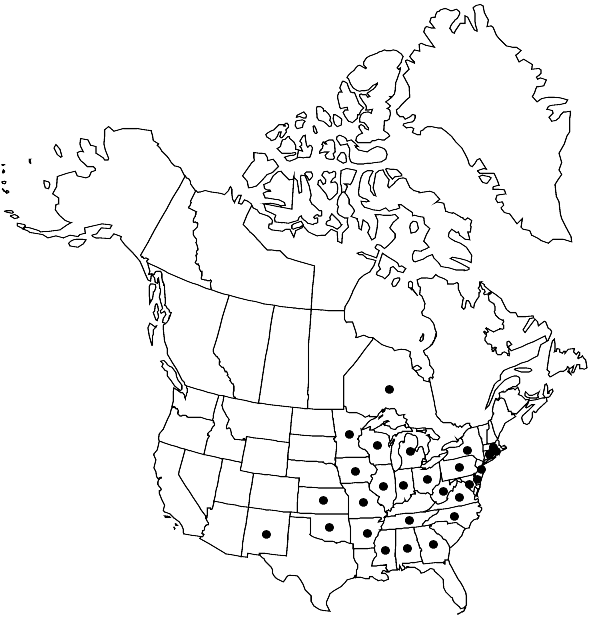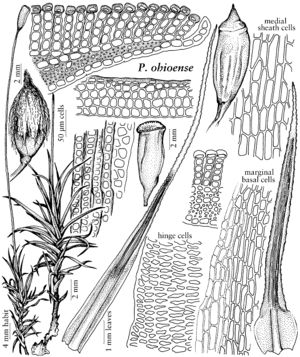Polytrichastrum ohioense
Mem. New York Bot. Gard. 21(3): 35. 1971,.
Plants moderately robust, dark-green to brown plants in loose tufts. Stems 1.5–3 (–6) cm high, usually unbranched, sparsely radiculose at or near the base. Leaves 6–10 mm, erect and loosely appressed with recurved tips when dry, spreading and broadly recurved when moist; sheath ovoid, hyaline-margined, golden brown, contracted to the blade, the cells at the shoulders forming a differentiated hinge; blade long-lanceolate, coarsely toothed at least in distal 2/3, acuminate, ending in a short, reddish, toothed awn; costa shortly excurrent, sparsely toothed abaxially near the tip; marginal lamina 1-stratose, narrow, mostly erect; lamellae 6–7 cells high, entire in side view, with nearly straight sides when viewed from above, the terminal cells in section rounded or more often transversely elliptical, ± flattopped, with a much smaller lumen than the others and the free wall conspicuously thickened, often brownish, smooth, sometimes finely striate-papillose; sheath cells 40–50 × 16–20 µm (3:1); cells of marginal lamina 12–15 µm, subquadrate; perichaetial leaves with long, sheathing bases and conspicuous golden yellow awns. Seta 2–9 cm, stout, yellowish, much longer than the leafy shoots. Capsule 3–5 mm, pale-brown, suberect to strongly inclined, 4-angled; hypophysis cylindric but not sharply delimited; exothecial cells not bulging or mammillose, without a central thin spot; stomata numerous, on the distal part of the hypophysis; peristome 300 µm, divided to 0.6, the teeth ca. 50, pale-brown. Spores 11–14 µm.
Habitat: Soil, humus, rocks, dry to moist woods
Elevation: low to moderate elevations
Distribution

Ont., Ala., Ark., Conn., Del., Ga., Ill., Ind., Iowa, Kans., Md., Mass., Mich., Minn., Miss., Mo., N.J., N.Mex., N.Y., N.C., Ohio, Okla., Pa., R.I., Tenn., Va., W.Va., Wis.
Discussion
Polytrichastrum ohioense is endemic to eastern North America, and is common in the Appalachian mixed oak (formerly oak-chestnut) forest, the oak-hickory forest of the interior United States (to eastern Kansas and Oklahoma), the oak-pine forests of the Atlantic coastal plain, and the maple-beech forest in Indiana, Ohio, southern Michigan, and Ontario. At higher elevations and in more northerly latitudes in coniferous forests, it is replaced by P. pallidisetum. An isolated population of P. ohioense occurs in a wooded canyon in the San Andres Mountains, northeast of Las Cruces, New Mexico. In the field, P. ohioense has a distinctive appearance. The seta typically far exceeds the leafy shoots in length, and the perichaetial leaves have conspicuous rough, golden yellow awns. The transversely elliptical, thick-walled marginal cells of the lamellae are also unique to this species. In side view the lamellae are entire, and the lumen greatly restricted. In P. pallidisetum the terminal cells of the lamellae are flat-topped to shallowly retuse, and in side view the lamellae are crenulate, their marginal cells not notably thick-walled.
Selected References
None.
Lower Taxa
"broadened" is not a number."um" is not declared as a valid unit of measurement for this property.
